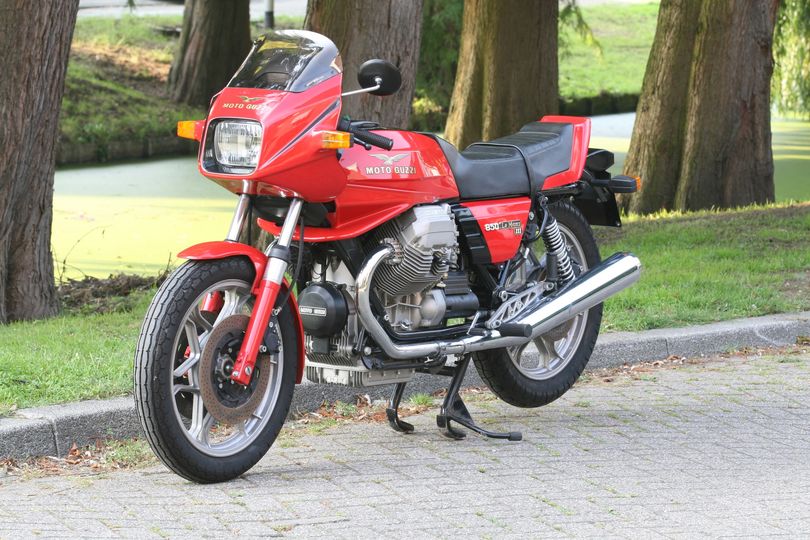Motorcycle Investor mag
Subscribe to our free email news
Moto Guzzi Le Mans MkIII
(by Ian Falloon, Feb 2022)

Falloon
unwraps an often-overlooked model
By the beginning of
the 1980s the Japanese motorcycle manufacturers finally
understood the balance
between power and chassis, unleashing a wave of powerful
motorcycles that
handled well. This left the European manufacturers in a
quandary. Without their
traditional handling advantage; where too next with
their ageing designs?
Moto Guzzi was in a
similar position to Ducati and Laverda. The Moto Guzzi
Le Mans had been one of
the standout sporting motorcycles of the mid 1970s but
by the end of the decade
the high compression twin was struggling to meet tougher
noise and emission
controls. While the Le Mans evolved into the similar
Mark II in 1978, by 1980
these big-valve twins breathing through open bell mouth
Dell’Orto carburettors
couldn’t be sold in most markets.
As sporting
motorcycles were still important for Moto Guzzi at that
time De Tomaso
sanctioned the development of an evolutionary Le Mans;
the 850 le Mans III.
When it was released it appeared to be a simple restyle,
but with 44 official
updates from the Le Mans II it was effectively a new
motorcycle.
Setting the Le Mans
III apart were new angular cylinders and heads, but the
capacity remained at
844cc, with 44 and 37mm valves. The pushrod and rocker
valve actuation set-up
was unchanged so valve adjustment remained an easy task.
A thicker cylinder
head gasket lowered the compression ratio slightly, to
9.8:1, and the Dell’Orto
PHF 36mm carburettors were new. As the days of open bell
mouth carburettors
were numbered, to maintain existing performance levels
the large capacity
air-cooled twin needed a more efficient intake and
exhaust system.
Guzzi’s engineers,
headed by the legendary Umberto Todero, managed to
create an airbox and exhaust
system that was quieter than the Le Mans and Le Mans II,
but produced more
power. A heavier crankshaft smoothed out low speed
running but the single plate
dry clutch, five-speed transmission and shaft final
drive were unchanged. The
factory claimed the Le Mans III’s power was increased
three horsepower over the
Le Mans II but didn’t actually provide a figure.
When it came to the
chassis it was very much business as usual with the Le
Mans III. Moto Guzzi
resisted the trend towards smaller wheels, fat tyres,
anti-dive braking, and
single shock rear suspension. A longer swingarm
stretched out the wheelbase to
1505mm, improving high-speed stability and providing
more room for a passenger.
But the narrow swingarm still only allowed a small
110/90-section rear tyre.
This wasn’t really a functional problem as wider tyres
were more fashionable
than necessary on the moderately powered sporting
Guzzis.
Moto Guzzi did follow
fashion by including air assistance for the front fork
and twin Paioli shocks.
The 18-inch cast FPS wheels were as before, as were the
integrated Brembo disc
brakes.
The Le Mans III was as
much about style as performance. From the reshaped
25-litre fuel tank, smaller
wind tunnel designed fairing, and new seat; it was
probably the dominant 100mm
white-faced Veglia tachometer that did as much to sell
the Le Mans III as
anything else. Despite the impressive cockpit, in many
respects the Le Mans III
was still a relic of the 1970s.
In 1981 there were few
motorcycles with battery and points ignition and a
skinny 35mm front fork. But
when it came to style and useable all-round performance
the Le Mans III was
very much as the forefront.
The claimed weight was
a reasonable 206kg, and it was an attractive machine.
While retaining the
compact dimensions of its predecessor the Le Mans III
provided performance
comparable to other 850 and 900cc twin cylinder
motorcycles.
The Le Mans III was
the perfect machine for riders who appreciated the
virtues and simplicity of
older motorcycles but required modern levels of
performance and civility.
Overlooked by serious collectors in favour of the V7
Sport and first series Le
Mans, the Le Mans III is a classic bargain.
-------------------------------------------------
Produced by AllMoto abn 61 400 694 722
Privacy: we do not collect cookies or any other data.

Archives
Contact





